Innovation, Creativity, and Entrepreneurship: Food and Beverage Report
VerifiedAdded on 2020/04/13
|21
|4454
|165
Report
AI Summary
This report delves into the concepts of innovation, creativity, and entrepreneurship within the food and beverage industry, focusing on the challenges and opportunities in the Czech Republic. It begins by defining these core concepts and then examines the specific challenges faced by the food and beverage sector, such as consumer preferences, health concerns regarding sugar levels, and the impact of e-commerce. The report identifies innovative solutions, including reducing sugar content, adding value to products, and leveraging e-commerce platforms. Furthermore, it analyzes the dimensions of innovation and explores Porter's generic strategies within the Czech Republic's food and beverage industry. The report also discusses the innovation culture canvas and the agents of innovation culture. The report emphasizes the importance of adapting to consumer trends, particularly the demand for healthier options and convenient online services, to ensure business success.
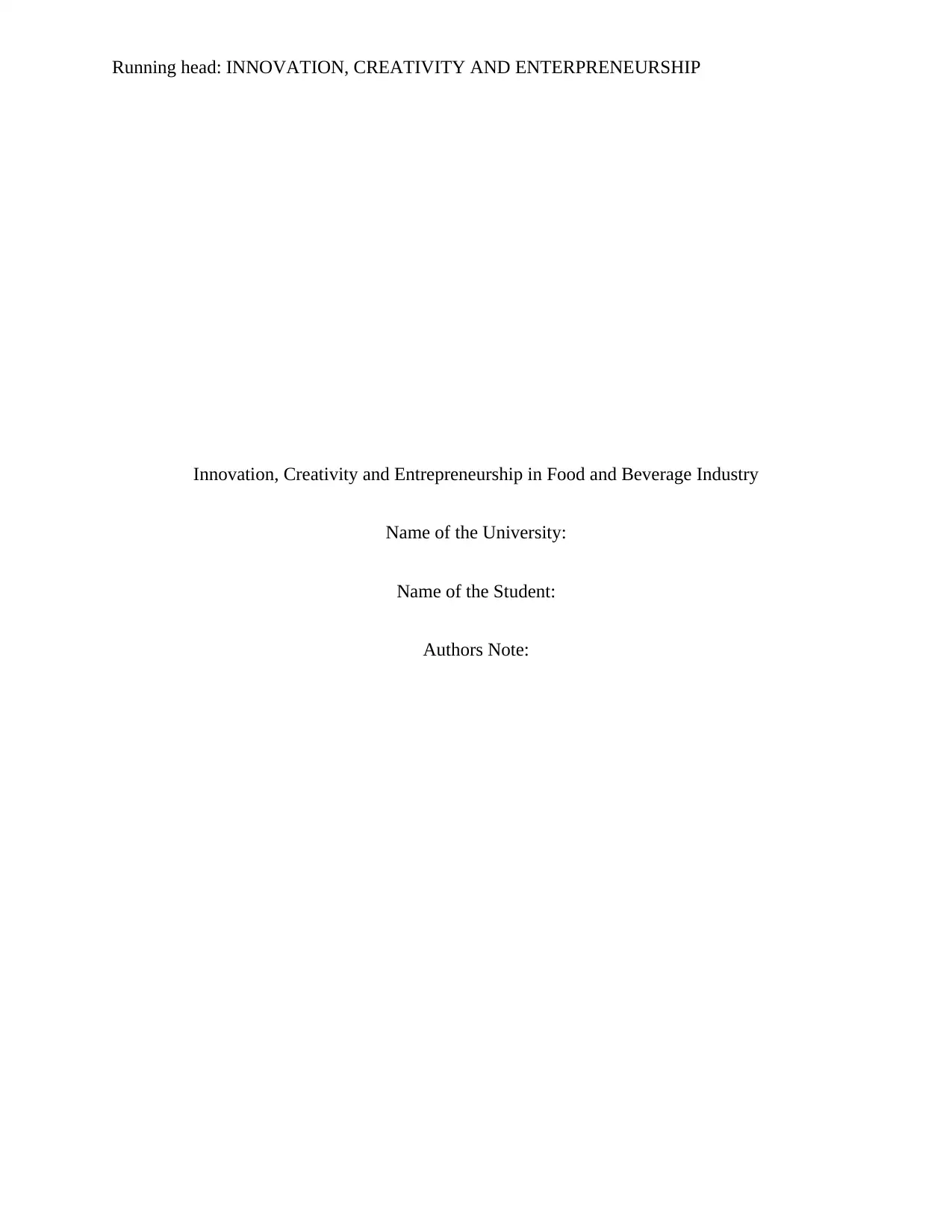
Running head: INNOVATION, CREATIVITY AND ENTERPRENEURSHIP
Innovation, Creativity and Entrepreneurship in Food and Beverage Industry
Name of the University:
Name of the Student:
Authors Note:
Innovation, Creativity and Entrepreneurship in Food and Beverage Industry
Name of the University:
Name of the Student:
Authors Note:
Paraphrase This Document
Need a fresh take? Get an instant paraphrase of this document with our AI Paraphraser
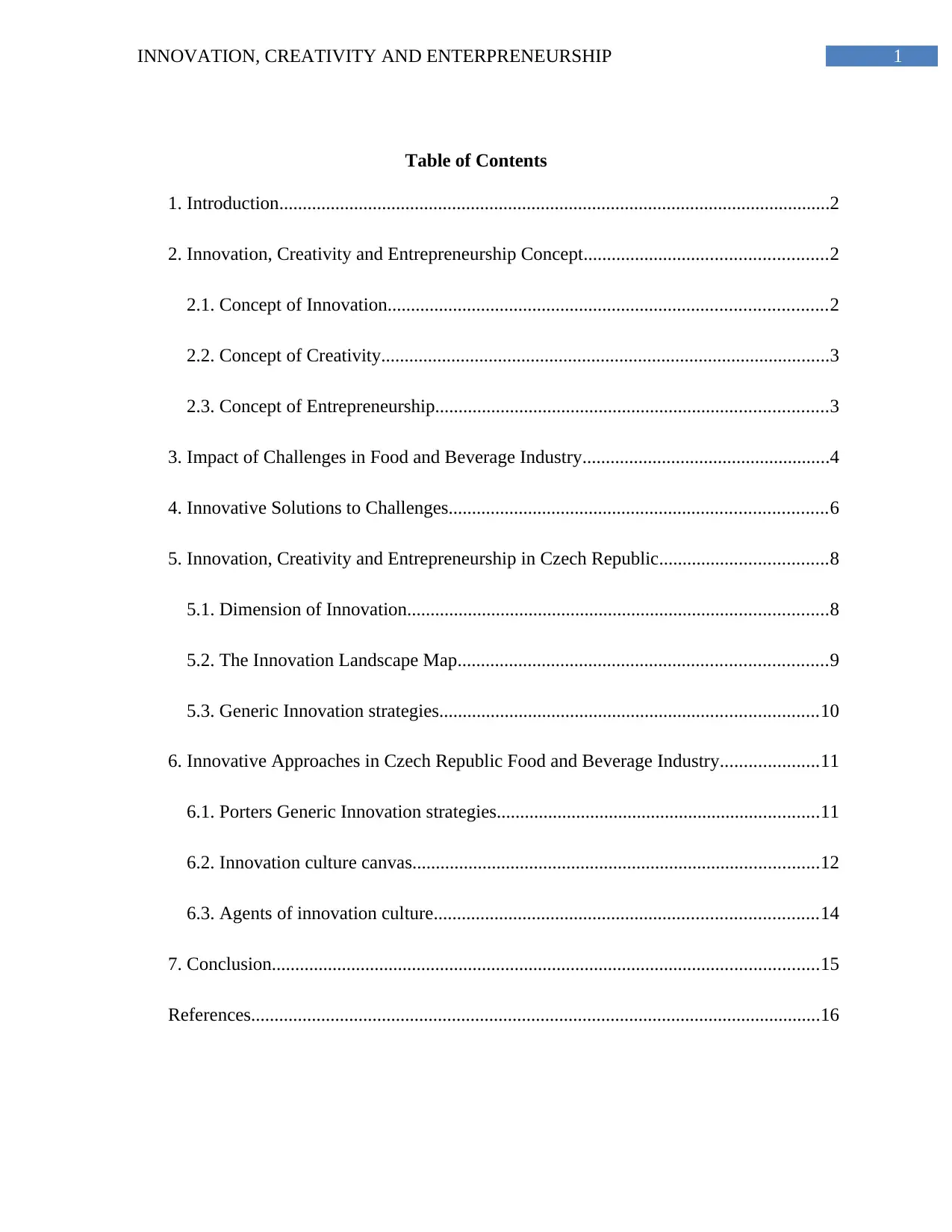
1INNOVATION, CREATIVITY AND ENTERPRENEURSHIP
Table of Contents
1. Introduction......................................................................................................................2
2. Innovation, Creativity and Entrepreneurship Concept....................................................2
2.1. Concept of Innovation..............................................................................................2
2.2. Concept of Creativity................................................................................................3
2.3. Concept of Entrepreneurship....................................................................................3
3. Impact of Challenges in Food and Beverage Industry.....................................................4
4. Innovative Solutions to Challenges.................................................................................6
5. Innovation, Creativity and Entrepreneurship in Czech Republic....................................8
5.1. Dimension of Innovation..........................................................................................8
5.2. The Innovation Landscape Map...............................................................................9
5.3. Generic Innovation strategies.................................................................................10
6. Innovative Approaches in Czech Republic Food and Beverage Industry.....................11
6.1. Porters Generic Innovation strategies.....................................................................11
6.2. Innovation culture canvas.......................................................................................12
6.3. Agents of innovation culture..................................................................................14
7. Conclusion.....................................................................................................................15
References..........................................................................................................................16
Table of Contents
1. Introduction......................................................................................................................2
2. Innovation, Creativity and Entrepreneurship Concept....................................................2
2.1. Concept of Innovation..............................................................................................2
2.2. Concept of Creativity................................................................................................3
2.3. Concept of Entrepreneurship....................................................................................3
3. Impact of Challenges in Food and Beverage Industry.....................................................4
4. Innovative Solutions to Challenges.................................................................................6
5. Innovation, Creativity and Entrepreneurship in Czech Republic....................................8
5.1. Dimension of Innovation..........................................................................................8
5.2. The Innovation Landscape Map...............................................................................9
5.3. Generic Innovation strategies.................................................................................10
6. Innovative Approaches in Czech Republic Food and Beverage Industry.....................11
6.1. Porters Generic Innovation strategies.....................................................................11
6.2. Innovation culture canvas.......................................................................................12
6.3. Agents of innovation culture..................................................................................14
7. Conclusion.....................................................................................................................15
References..........................................................................................................................16

2INNOVATION, CREATIVITY AND ENTERPRENEURSHIP
⊘ This is a preview!⊘
Do you want full access?
Subscribe today to unlock all pages.

Trusted by 1+ million students worldwide
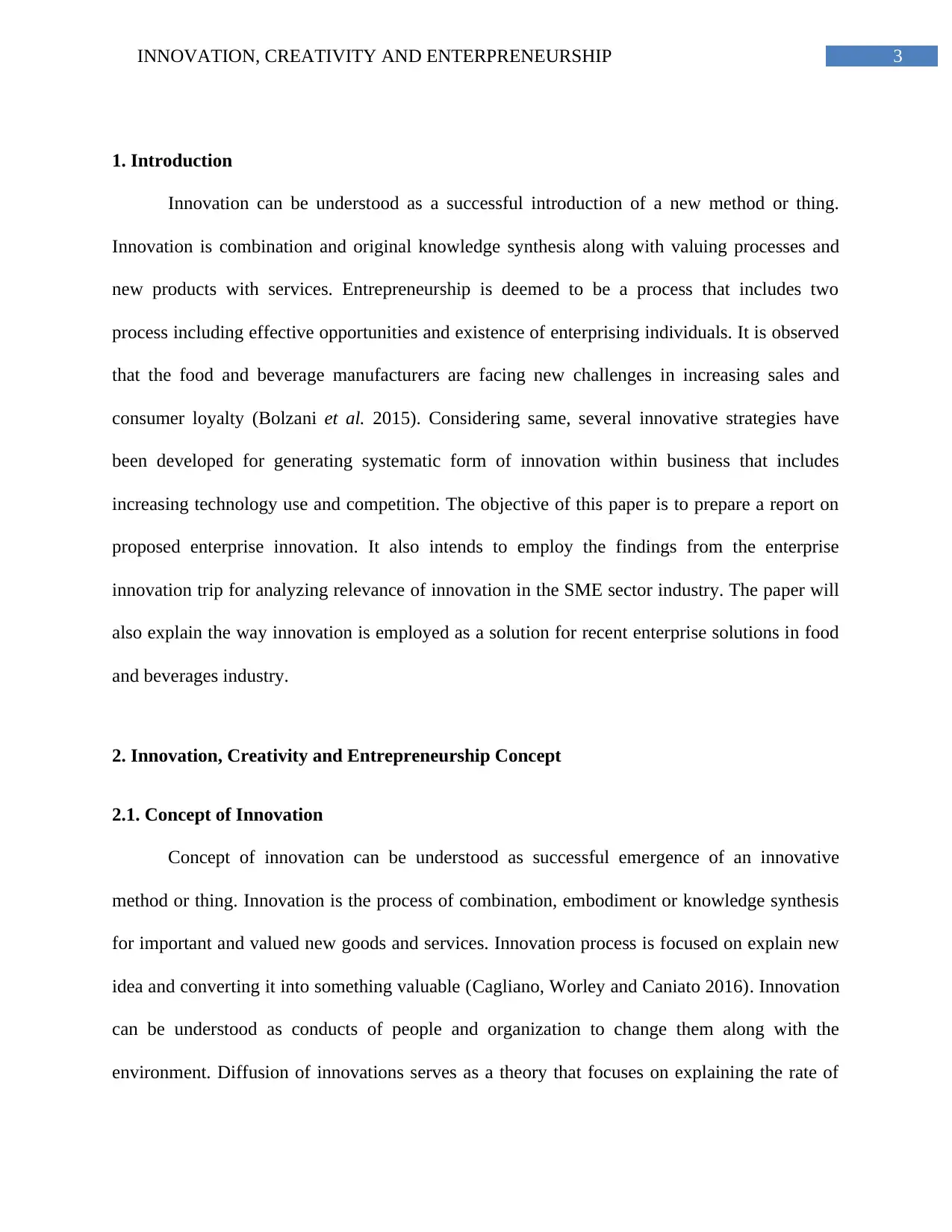
3INNOVATION, CREATIVITY AND ENTERPRENEURSHIP
1. Introduction
Innovation can be understood as a successful introduction of a new method or thing.
Innovation is combination and original knowledge synthesis along with valuing processes and
new products with services. Entrepreneurship is deemed to be a process that includes two
process including effective opportunities and existence of enterprising individuals. It is observed
that the food and beverage manufacturers are facing new challenges in increasing sales and
consumer loyalty (Bolzani et al. 2015). Considering same, several innovative strategies have
been developed for generating systematic form of innovation within business that includes
increasing technology use and competition. The objective of this paper is to prepare a report on
proposed enterprise innovation. It also intends to employ the findings from the enterprise
innovation trip for analyzing relevance of innovation in the SME sector industry. The paper will
also explain the way innovation is employed as a solution for recent enterprise solutions in food
and beverages industry.
2. Innovation, Creativity and Entrepreneurship Concept
2.1. Concept of Innovation
Concept of innovation can be understood as successful emergence of an innovative
method or thing. Innovation is the process of combination, embodiment or knowledge synthesis
for important and valued new goods and services. Innovation process is focused on explain new
idea and converting it into something valuable (Cagliano, Worley and Caniato 2016). Innovation
can be understood as conducts of people and organization to change them along with the
environment. Diffusion of innovations serves as a theory that focuses on explaining the rate of
1. Introduction
Innovation can be understood as a successful introduction of a new method or thing.
Innovation is combination and original knowledge synthesis along with valuing processes and
new products with services. Entrepreneurship is deemed to be a process that includes two
process including effective opportunities and existence of enterprising individuals. It is observed
that the food and beverage manufacturers are facing new challenges in increasing sales and
consumer loyalty (Bolzani et al. 2015). Considering same, several innovative strategies have
been developed for generating systematic form of innovation within business that includes
increasing technology use and competition. The objective of this paper is to prepare a report on
proposed enterprise innovation. It also intends to employ the findings from the enterprise
innovation trip for analyzing relevance of innovation in the SME sector industry. The paper will
also explain the way innovation is employed as a solution for recent enterprise solutions in food
and beverages industry.
2. Innovation, Creativity and Entrepreneurship Concept
2.1. Concept of Innovation
Concept of innovation can be understood as successful emergence of an innovative
method or thing. Innovation is the process of combination, embodiment or knowledge synthesis
for important and valued new goods and services. Innovation process is focused on explain new
idea and converting it into something valuable (Cagliano, Worley and Caniato 2016). Innovation
can be understood as conducts of people and organization to change them along with the
environment. Diffusion of innovations serves as a theory that focuses on explaining the rate of
Paraphrase This Document
Need a fresh take? Get an instant paraphrase of this document with our AI Paraphraser
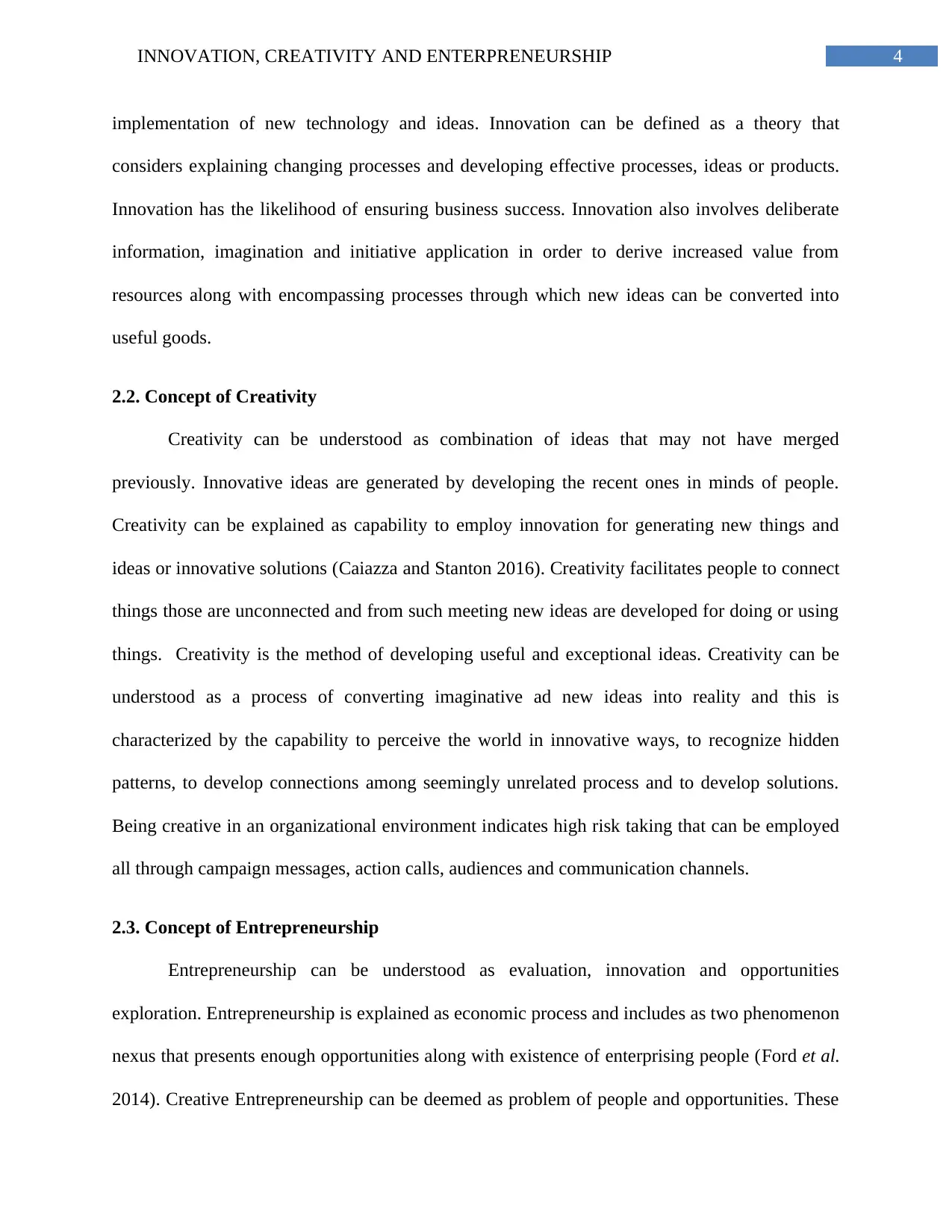
4INNOVATION, CREATIVITY AND ENTERPRENEURSHIP
implementation of new technology and ideas. Innovation can be defined as a theory that
considers explaining changing processes and developing effective processes, ideas or products.
Innovation has the likelihood of ensuring business success. Innovation also involves deliberate
information, imagination and initiative application in order to derive increased value from
resources along with encompassing processes through which new ideas can be converted into
useful goods.
2.2. Concept of Creativity
Creativity can be understood as combination of ideas that may not have merged
previously. Innovative ideas are generated by developing the recent ones in minds of people.
Creativity can be explained as capability to employ innovation for generating new things and
ideas or innovative solutions (Caiazza and Stanton 2016). Creativity facilitates people to connect
things those are unconnected and from such meeting new ideas are developed for doing or using
things. Creativity is the method of developing useful and exceptional ideas. Creativity can be
understood as a process of converting imaginative ad new ideas into reality and this is
characterized by the capability to perceive the world in innovative ways, to recognize hidden
patterns, to develop connections among seemingly unrelated process and to develop solutions.
Being creative in an organizational environment indicates high risk taking that can be employed
all through campaign messages, action calls, audiences and communication channels.
2.3. Concept of Entrepreneurship
Entrepreneurship can be understood as evaluation, innovation and opportunities
exploration. Entrepreneurship is explained as economic process and includes as two phenomenon
nexus that presents enough opportunities along with existence of enterprising people (Ford et al.
2014). Creative Entrepreneurship can be deemed as problem of people and opportunities. These
implementation of new technology and ideas. Innovation can be defined as a theory that
considers explaining changing processes and developing effective processes, ideas or products.
Innovation has the likelihood of ensuring business success. Innovation also involves deliberate
information, imagination and initiative application in order to derive increased value from
resources along with encompassing processes through which new ideas can be converted into
useful goods.
2.2. Concept of Creativity
Creativity can be understood as combination of ideas that may not have merged
previously. Innovative ideas are generated by developing the recent ones in minds of people.
Creativity can be explained as capability to employ innovation for generating new things and
ideas or innovative solutions (Caiazza and Stanton 2016). Creativity facilitates people to connect
things those are unconnected and from such meeting new ideas are developed for doing or using
things. Creativity is the method of developing useful and exceptional ideas. Creativity can be
understood as a process of converting imaginative ad new ideas into reality and this is
characterized by the capability to perceive the world in innovative ways, to recognize hidden
patterns, to develop connections among seemingly unrelated process and to develop solutions.
Being creative in an organizational environment indicates high risk taking that can be employed
all through campaign messages, action calls, audiences and communication channels.
2.3. Concept of Entrepreneurship
Entrepreneurship can be understood as evaluation, innovation and opportunities
exploration. Entrepreneurship is explained as economic process and includes as two phenomenon
nexus that presents enough opportunities along with existence of enterprising people (Ford et al.
2014). Creative Entrepreneurship can be deemed as problem of people and opportunities. These
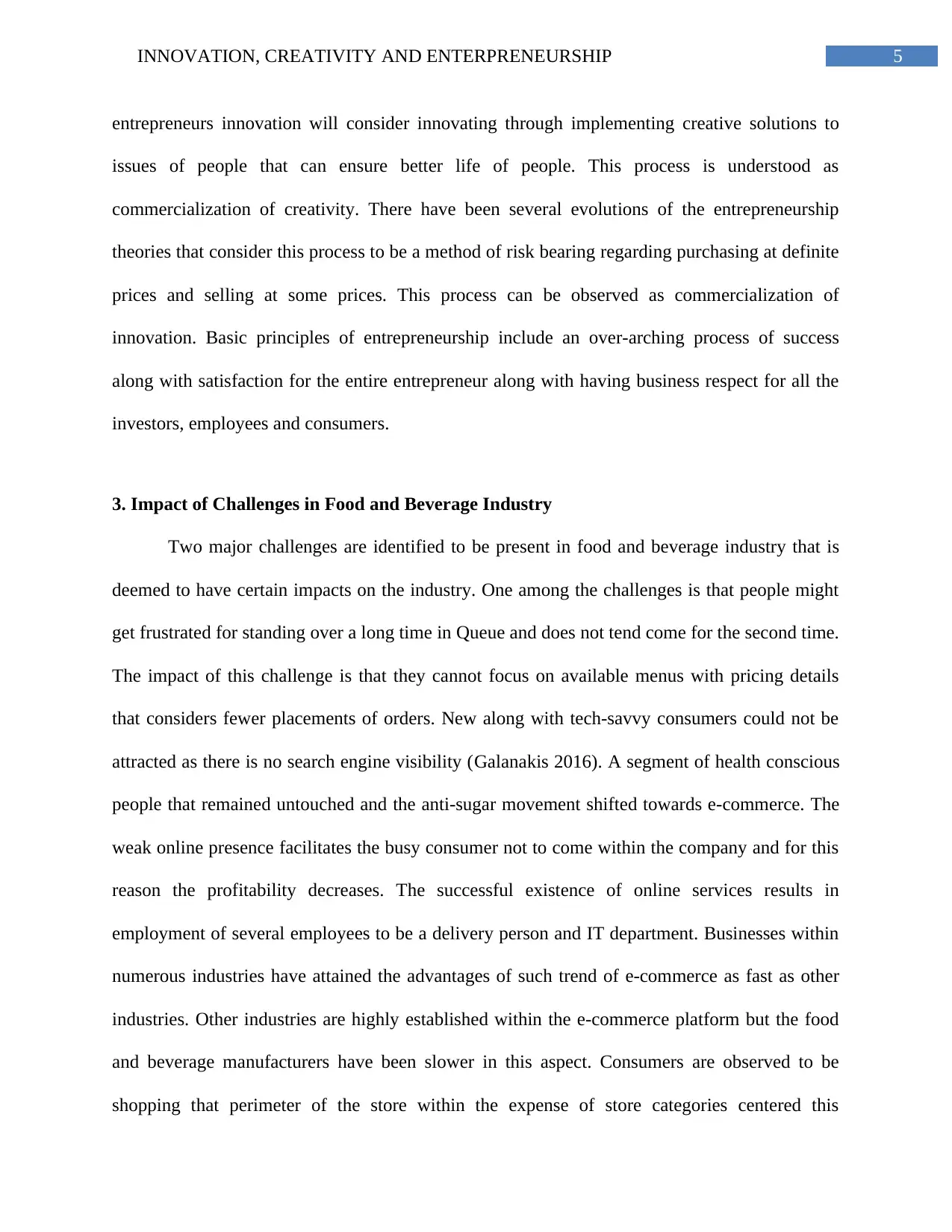
5INNOVATION, CREATIVITY AND ENTERPRENEURSHIP
entrepreneurs innovation will consider innovating through implementing creative solutions to
issues of people that can ensure better life of people. This process is understood as
commercialization of creativity. There have been several evolutions of the entrepreneurship
theories that consider this process to be a method of risk bearing regarding purchasing at definite
prices and selling at some prices. This process can be observed as commercialization of
innovation. Basic principles of entrepreneurship include an over-arching process of success
along with satisfaction for the entire entrepreneur along with having business respect for all the
investors, employees and consumers.
3. Impact of Challenges in Food and Beverage Industry
Two major challenges are identified to be present in food and beverage industry that is
deemed to have certain impacts on the industry. One among the challenges is that people might
get frustrated for standing over a long time in Queue and does not tend come for the second time.
The impact of this challenge is that they cannot focus on available menus with pricing details
that considers fewer placements of orders. New along with tech-savvy consumers could not be
attracted as there is no search engine visibility (Galanakis 2016). A segment of health conscious
people that remained untouched and the anti-sugar movement shifted towards e-commerce. The
weak online presence facilitates the busy consumer not to come within the company and for this
reason the profitability decreases. The successful existence of online services results in
employment of several employees to be a delivery person and IT department. Businesses within
numerous industries have attained the advantages of such trend of e-commerce as fast as other
industries. Other industries are highly established within the e-commerce platform but the food
and beverage manufacturers have been slower in this aspect. Consumers are observed to be
shopping that perimeter of the store within the expense of store categories centered this
entrepreneurs innovation will consider innovating through implementing creative solutions to
issues of people that can ensure better life of people. This process is understood as
commercialization of creativity. There have been several evolutions of the entrepreneurship
theories that consider this process to be a method of risk bearing regarding purchasing at definite
prices and selling at some prices. This process can be observed as commercialization of
innovation. Basic principles of entrepreneurship include an over-arching process of success
along with satisfaction for the entire entrepreneur along with having business respect for all the
investors, employees and consumers.
3. Impact of Challenges in Food and Beverage Industry
Two major challenges are identified to be present in food and beverage industry that is
deemed to have certain impacts on the industry. One among the challenges is that people might
get frustrated for standing over a long time in Queue and does not tend come for the second time.
The impact of this challenge is that they cannot focus on available menus with pricing details
that considers fewer placements of orders. New along with tech-savvy consumers could not be
attracted as there is no search engine visibility (Galanakis 2016). A segment of health conscious
people that remained untouched and the anti-sugar movement shifted towards e-commerce. The
weak online presence facilitates the busy consumer not to come within the company and for this
reason the profitability decreases. The successful existence of online services results in
employment of several employees to be a delivery person and IT department. Businesses within
numerous industries have attained the advantages of such trend of e-commerce as fast as other
industries. Other industries are highly established within the e-commerce platform but the food
and beverage manufacturers have been slower in this aspect. Consumers are observed to be
shopping that perimeter of the store within the expense of store categories centered this
⊘ This is a preview!⊘
Do you want full access?
Subscribe today to unlock all pages.

Trusted by 1+ million students worldwide
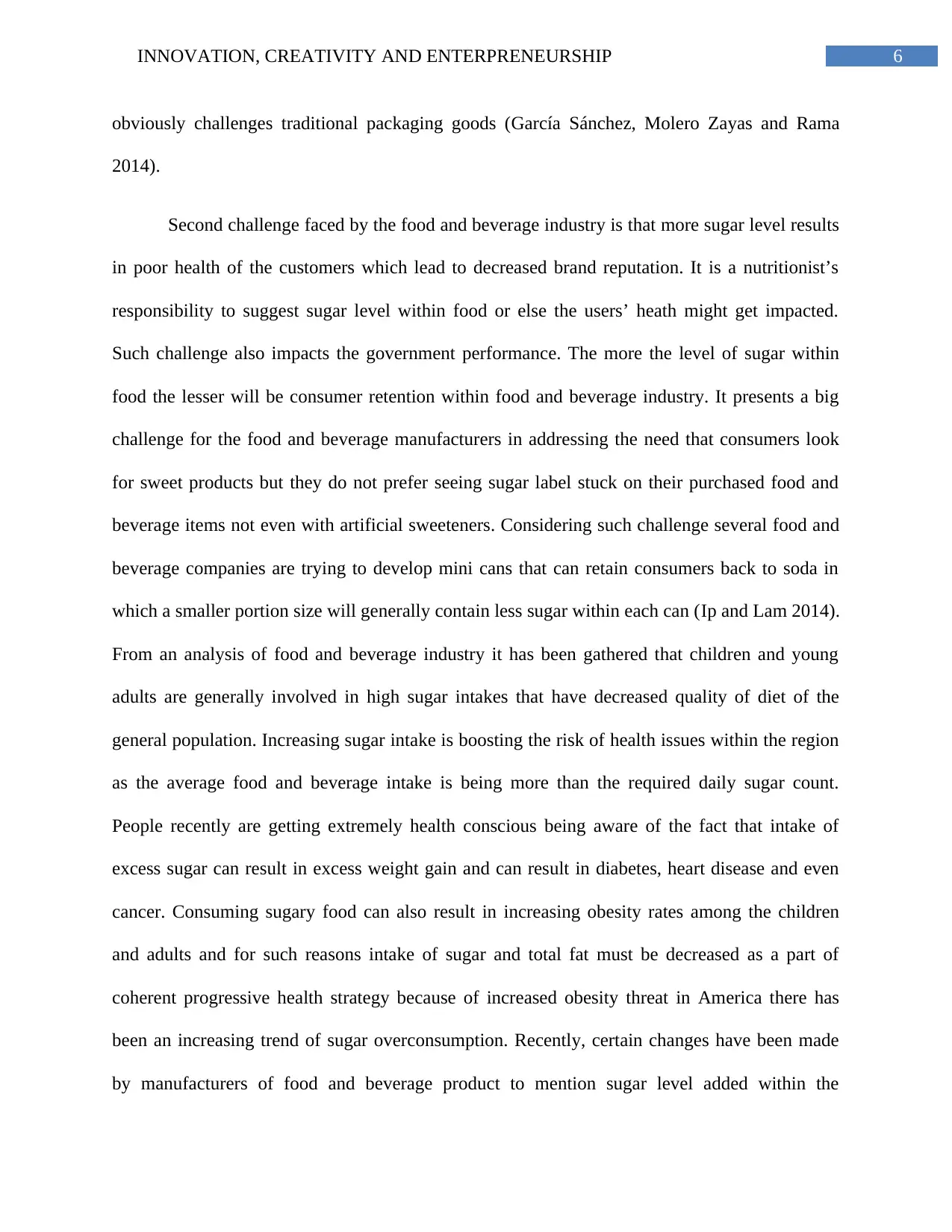
6INNOVATION, CREATIVITY AND ENTERPRENEURSHIP
obviously challenges traditional packaging goods (García Sánchez, Molero Zayas and Rama
2014).
Second challenge faced by the food and beverage industry is that more sugar level results
in poor health of the customers which lead to decreased brand reputation. It is a nutritionist’s
responsibility to suggest sugar level within food or else the users’ heath might get impacted.
Such challenge also impacts the government performance. The more the level of sugar within
food the lesser will be consumer retention within food and beverage industry. It presents a big
challenge for the food and beverage manufacturers in addressing the need that consumers look
for sweet products but they do not prefer seeing sugar label stuck on their purchased food and
beverage items not even with artificial sweeteners. Considering such challenge several food and
beverage companies are trying to develop mini cans that can retain consumers back to soda in
which a smaller portion size will generally contain less sugar within each can (Ip and Lam 2014).
From an analysis of food and beverage industry it has been gathered that children and young
adults are generally involved in high sugar intakes that have decreased quality of diet of the
general population. Increasing sugar intake is boosting the risk of health issues within the region
as the average food and beverage intake is being more than the required daily sugar count.
People recently are getting extremely health conscious being aware of the fact that intake of
excess sugar can result in excess weight gain and can result in diabetes, heart disease and even
cancer. Consuming sugary food can also result in increasing obesity rates among the children
and adults and for such reasons intake of sugar and total fat must be decreased as a part of
coherent progressive health strategy because of increased obesity threat in America there has
been an increasing trend of sugar overconsumption. Recently, certain changes have been made
by manufacturers of food and beverage product to mention sugar level added within the
obviously challenges traditional packaging goods (García Sánchez, Molero Zayas and Rama
2014).
Second challenge faced by the food and beverage industry is that more sugar level results
in poor health of the customers which lead to decreased brand reputation. It is a nutritionist’s
responsibility to suggest sugar level within food or else the users’ heath might get impacted.
Such challenge also impacts the government performance. The more the level of sugar within
food the lesser will be consumer retention within food and beverage industry. It presents a big
challenge for the food and beverage manufacturers in addressing the need that consumers look
for sweet products but they do not prefer seeing sugar label stuck on their purchased food and
beverage items not even with artificial sweeteners. Considering such challenge several food and
beverage companies are trying to develop mini cans that can retain consumers back to soda in
which a smaller portion size will generally contain less sugar within each can (Ip and Lam 2014).
From an analysis of food and beverage industry it has been gathered that children and young
adults are generally involved in high sugar intakes that have decreased quality of diet of the
general population. Increasing sugar intake is boosting the risk of health issues within the region
as the average food and beverage intake is being more than the required daily sugar count.
People recently are getting extremely health conscious being aware of the fact that intake of
excess sugar can result in excess weight gain and can result in diabetes, heart disease and even
cancer. Consuming sugary food can also result in increasing obesity rates among the children
and adults and for such reasons intake of sugar and total fat must be decreased as a part of
coherent progressive health strategy because of increased obesity threat in America there has
been an increasing trend of sugar overconsumption. Recently, certain changes have been made
by manufacturers of food and beverage product to mention sugar level added within the
Paraphrase This Document
Need a fresh take? Get an instant paraphrase of this document with our AI Paraphraser
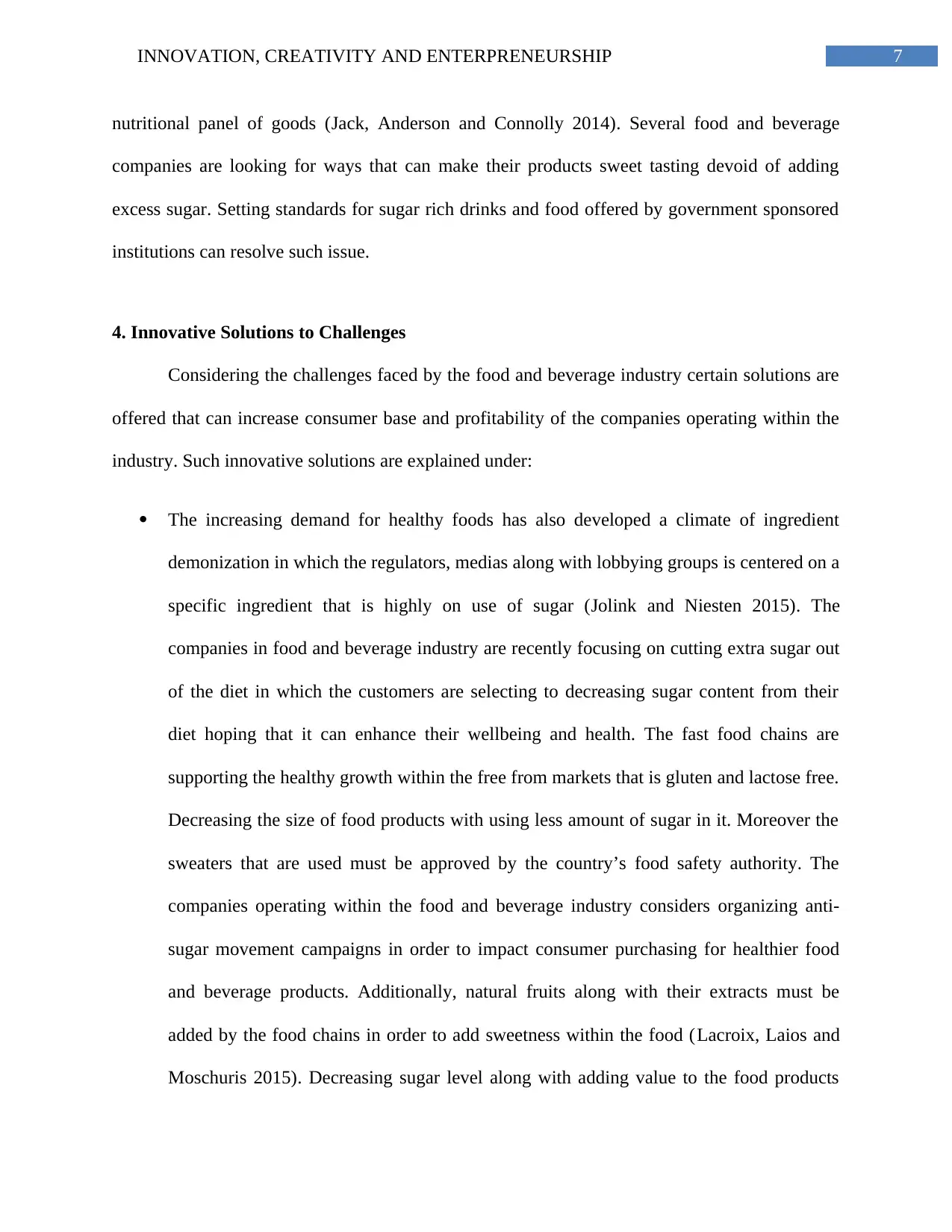
7INNOVATION, CREATIVITY AND ENTERPRENEURSHIP
nutritional panel of goods (Jack, Anderson and Connolly 2014). Several food and beverage
companies are looking for ways that can make their products sweet tasting devoid of adding
excess sugar. Setting standards for sugar rich drinks and food offered by government sponsored
institutions can resolve such issue.
4. Innovative Solutions to Challenges
Considering the challenges faced by the food and beverage industry certain solutions are
offered that can increase consumer base and profitability of the companies operating within the
industry. Such innovative solutions are explained under:
The increasing demand for healthy foods has also developed a climate of ingredient
demonization in which the regulators, medias along with lobbying groups is centered on a
specific ingredient that is highly on use of sugar (Jolink and Niesten 2015). The
companies in food and beverage industry are recently focusing on cutting extra sugar out
of the diet in which the customers are selecting to decreasing sugar content from their
diet hoping that it can enhance their wellbeing and health. The fast food chains are
supporting the healthy growth within the free from markets that is gluten and lactose free.
Decreasing the size of food products with using less amount of sugar in it. Moreover the
sweaters that are used must be approved by the country’s food safety authority. The
companies operating within the food and beverage industry considers organizing anti-
sugar movement campaigns in order to impact consumer purchasing for healthier food
and beverage products. Additionally, natural fruits along with their extracts must be
added by the food chains in order to add sweetness within the food (Lacroix, Laios and
Moschuris 2015). Decreasing sugar level along with adding value to the food products
nutritional panel of goods (Jack, Anderson and Connolly 2014). Several food and beverage
companies are looking for ways that can make their products sweet tasting devoid of adding
excess sugar. Setting standards for sugar rich drinks and food offered by government sponsored
institutions can resolve such issue.
4. Innovative Solutions to Challenges
Considering the challenges faced by the food and beverage industry certain solutions are
offered that can increase consumer base and profitability of the companies operating within the
industry. Such innovative solutions are explained under:
The increasing demand for healthy foods has also developed a climate of ingredient
demonization in which the regulators, medias along with lobbying groups is centered on a
specific ingredient that is highly on use of sugar (Jolink and Niesten 2015). The
companies in food and beverage industry are recently focusing on cutting extra sugar out
of the diet in which the customers are selecting to decreasing sugar content from their
diet hoping that it can enhance their wellbeing and health. The fast food chains are
supporting the healthy growth within the free from markets that is gluten and lactose free.
Decreasing the size of food products with using less amount of sugar in it. Moreover the
sweaters that are used must be approved by the country’s food safety authority. The
companies operating within the food and beverage industry considers organizing anti-
sugar movement campaigns in order to impact consumer purchasing for healthier food
and beverage products. Additionally, natural fruits along with their extracts must be
added by the food chains in order to add sweetness within the food (Lacroix, Laios and
Moschuris 2015). Decreasing sugar level along with adding value to the food products
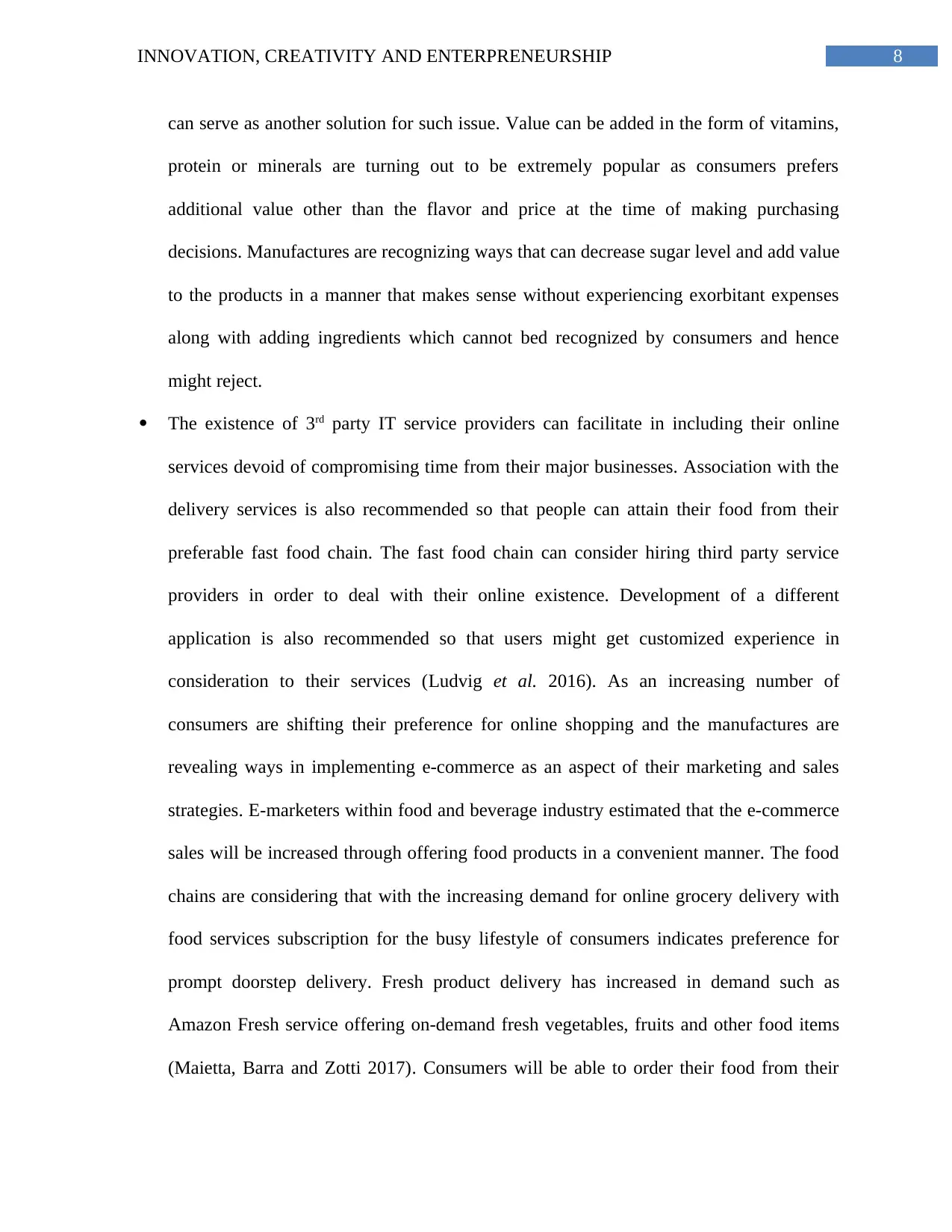
8INNOVATION, CREATIVITY AND ENTERPRENEURSHIP
can serve as another solution for such issue. Value can be added in the form of vitamins,
protein or minerals are turning out to be extremely popular as consumers prefers
additional value other than the flavor and price at the time of making purchasing
decisions. Manufactures are recognizing ways that can decrease sugar level and add value
to the products in a manner that makes sense without experiencing exorbitant expenses
along with adding ingredients which cannot bed recognized by consumers and hence
might reject.
The existence of 3rd party IT service providers can facilitate in including their online
services devoid of compromising time from their major businesses. Association with the
delivery services is also recommended so that people can attain their food from their
preferable fast food chain. The fast food chain can consider hiring third party service
providers in order to deal with their online existence. Development of a different
application is also recommended so that users might get customized experience in
consideration to their services (Ludvig et al. 2016). As an increasing number of
consumers are shifting their preference for online shopping and the manufactures are
revealing ways in implementing e-commerce as an aspect of their marketing and sales
strategies. E-marketers within food and beverage industry estimated that the e-commerce
sales will be increased through offering food products in a convenient manner. The food
chains are considering that with the increasing demand for online grocery delivery with
food services subscription for the busy lifestyle of consumers indicates preference for
prompt doorstep delivery. Fresh product delivery has increased in demand such as
Amazon Fresh service offering on-demand fresh vegetables, fruits and other food items
(Maietta, Barra and Zotti 2017). Consumers will be able to order their food from their
can serve as another solution for such issue. Value can be added in the form of vitamins,
protein or minerals are turning out to be extremely popular as consumers prefers
additional value other than the flavor and price at the time of making purchasing
decisions. Manufactures are recognizing ways that can decrease sugar level and add value
to the products in a manner that makes sense without experiencing exorbitant expenses
along with adding ingredients which cannot bed recognized by consumers and hence
might reject.
The existence of 3rd party IT service providers can facilitate in including their online
services devoid of compromising time from their major businesses. Association with the
delivery services is also recommended so that people can attain their food from their
preferable fast food chain. The fast food chain can consider hiring third party service
providers in order to deal with their online existence. Development of a different
application is also recommended so that users might get customized experience in
consideration to their services (Ludvig et al. 2016). As an increasing number of
consumers are shifting their preference for online shopping and the manufactures are
revealing ways in implementing e-commerce as an aspect of their marketing and sales
strategies. E-marketers within food and beverage industry estimated that the e-commerce
sales will be increased through offering food products in a convenient manner. The food
chains are considering that with the increasing demand for online grocery delivery with
food services subscription for the busy lifestyle of consumers indicates preference for
prompt doorstep delivery. Fresh product delivery has increased in demand such as
Amazon Fresh service offering on-demand fresh vegetables, fruits and other food items
(Maietta, Barra and Zotti 2017). Consumers will be able to order their food from their
⊘ This is a preview!⊘
Do you want full access?
Subscribe today to unlock all pages.

Trusted by 1+ million students worldwide
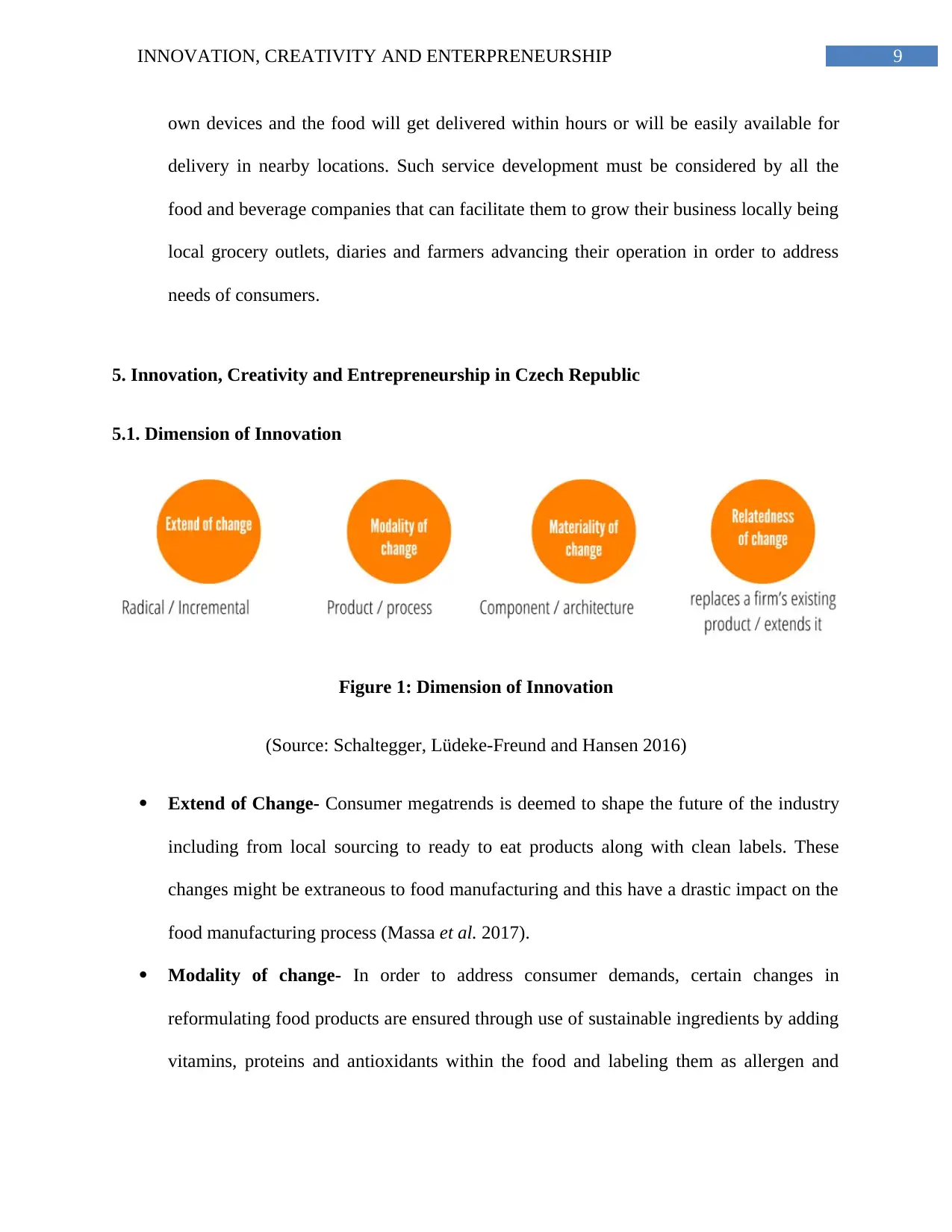
9INNOVATION, CREATIVITY AND ENTERPRENEURSHIP
own devices and the food will get delivered within hours or will be easily available for
delivery in nearby locations. Such service development must be considered by all the
food and beverage companies that can facilitate them to grow their business locally being
local grocery outlets, diaries and farmers advancing their operation in order to address
needs of consumers.
5. Innovation, Creativity and Entrepreneurship in Czech Republic
5.1. Dimension of Innovation
Figure 1: Dimension of Innovation
(Source: Schaltegger, Lüdeke-Freund and Hansen 2016)
Extend of Change- Consumer megatrends is deemed to shape the future of the industry
including from local sourcing to ready to eat products along with clean labels. These
changes might be extraneous to food manufacturing and this have a drastic impact on the
food manufacturing process (Massa et al. 2017).
Modality of change- In order to address consumer demands, certain changes in
reformulating food products are ensured through use of sustainable ingredients by adding
vitamins, proteins and antioxidants within the food and labeling them as allergen and
own devices and the food will get delivered within hours or will be easily available for
delivery in nearby locations. Such service development must be considered by all the
food and beverage companies that can facilitate them to grow their business locally being
local grocery outlets, diaries and farmers advancing their operation in order to address
needs of consumers.
5. Innovation, Creativity and Entrepreneurship in Czech Republic
5.1. Dimension of Innovation
Figure 1: Dimension of Innovation
(Source: Schaltegger, Lüdeke-Freund and Hansen 2016)
Extend of Change- Consumer megatrends is deemed to shape the future of the industry
including from local sourcing to ready to eat products along with clean labels. These
changes might be extraneous to food manufacturing and this have a drastic impact on the
food manufacturing process (Massa et al. 2017).
Modality of change- In order to address consumer demands, certain changes in
reformulating food products are ensured through use of sustainable ingredients by adding
vitamins, proteins and antioxidants within the food and labeling them as allergen and
Paraphrase This Document
Need a fresh take? Get an instant paraphrase of this document with our AI Paraphraser
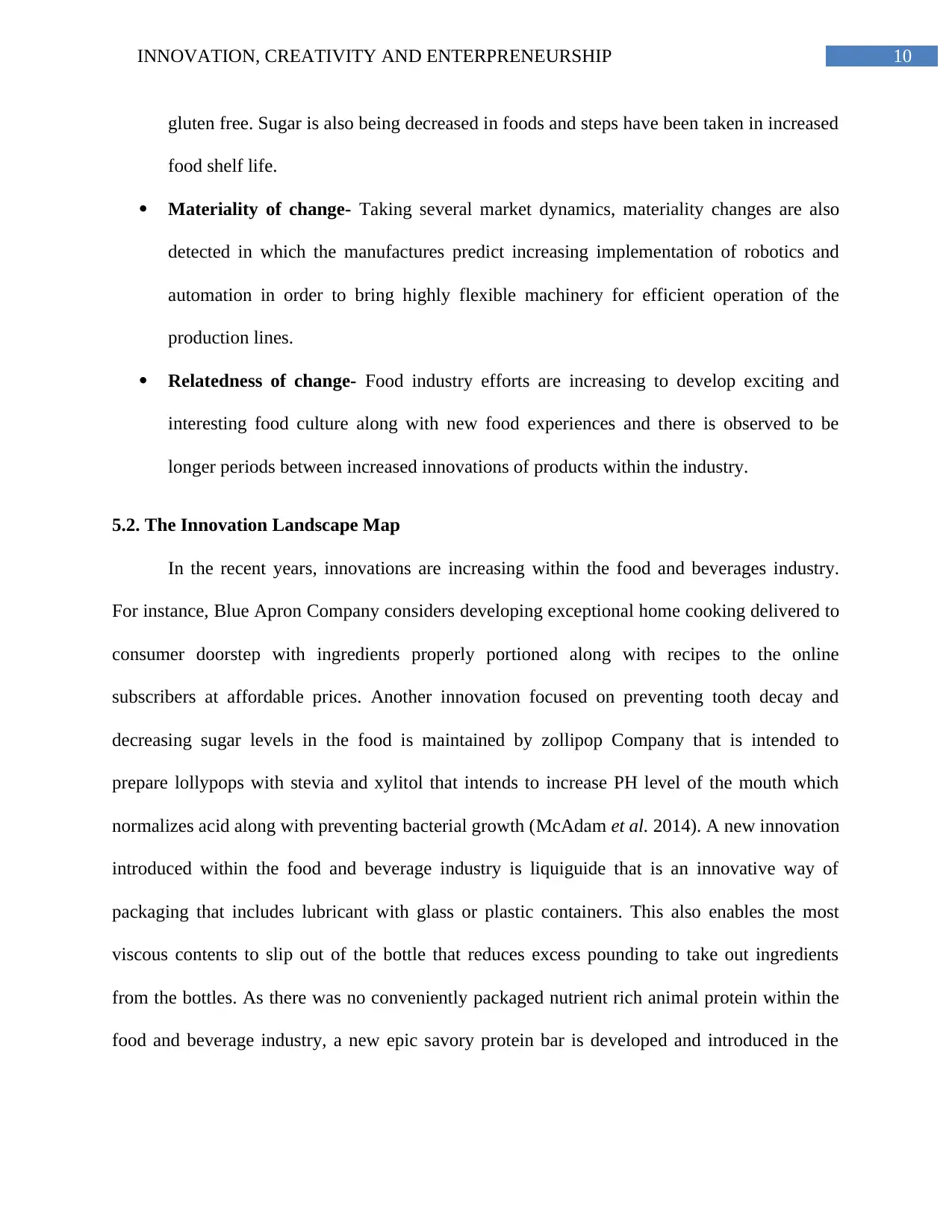
10INNOVATION, CREATIVITY AND ENTERPRENEURSHIP
gluten free. Sugar is also being decreased in foods and steps have been taken in increased
food shelf life.
Materiality of change- Taking several market dynamics, materiality changes are also
detected in which the manufactures predict increasing implementation of robotics and
automation in order to bring highly flexible machinery for efficient operation of the
production lines.
Relatedness of change- Food industry efforts are increasing to develop exciting and
interesting food culture along with new food experiences and there is observed to be
longer periods between increased innovations of products within the industry.
5.2. The Innovation Landscape Map
In the recent years, innovations are increasing within the food and beverages industry.
For instance, Blue Apron Company considers developing exceptional home cooking delivered to
consumer doorstep with ingredients properly portioned along with recipes to the online
subscribers at affordable prices. Another innovation focused on preventing tooth decay and
decreasing sugar levels in the food is maintained by zollipop Company that is intended to
prepare lollypops with stevia and xylitol that intends to increase PH level of the mouth which
normalizes acid along with preventing bacterial growth (McAdam et al. 2014). A new innovation
introduced within the food and beverage industry is liquiguide that is an innovative way of
packaging that includes lubricant with glass or plastic containers. This also enables the most
viscous contents to slip out of the bottle that reduces excess pounding to take out ingredients
from the bottles. As there was no conveniently packaged nutrient rich animal protein within the
food and beverage industry, a new epic savory protein bar is developed and introduced in the
gluten free. Sugar is also being decreased in foods and steps have been taken in increased
food shelf life.
Materiality of change- Taking several market dynamics, materiality changes are also
detected in which the manufactures predict increasing implementation of robotics and
automation in order to bring highly flexible machinery for efficient operation of the
production lines.
Relatedness of change- Food industry efforts are increasing to develop exciting and
interesting food culture along with new food experiences and there is observed to be
longer periods between increased innovations of products within the industry.
5.2. The Innovation Landscape Map
In the recent years, innovations are increasing within the food and beverages industry.
For instance, Blue Apron Company considers developing exceptional home cooking delivered to
consumer doorstep with ingredients properly portioned along with recipes to the online
subscribers at affordable prices. Another innovation focused on preventing tooth decay and
decreasing sugar levels in the food is maintained by zollipop Company that is intended to
prepare lollypops with stevia and xylitol that intends to increase PH level of the mouth which
normalizes acid along with preventing bacterial growth (McAdam et al. 2014). A new innovation
introduced within the food and beverage industry is liquiguide that is an innovative way of
packaging that includes lubricant with glass or plastic containers. This also enables the most
viscous contents to slip out of the bottle that reduces excess pounding to take out ingredients
from the bottles. As there was no conveniently packaged nutrient rich animal protein within the
food and beverage industry, a new epic savory protein bar is developed and introduced in the
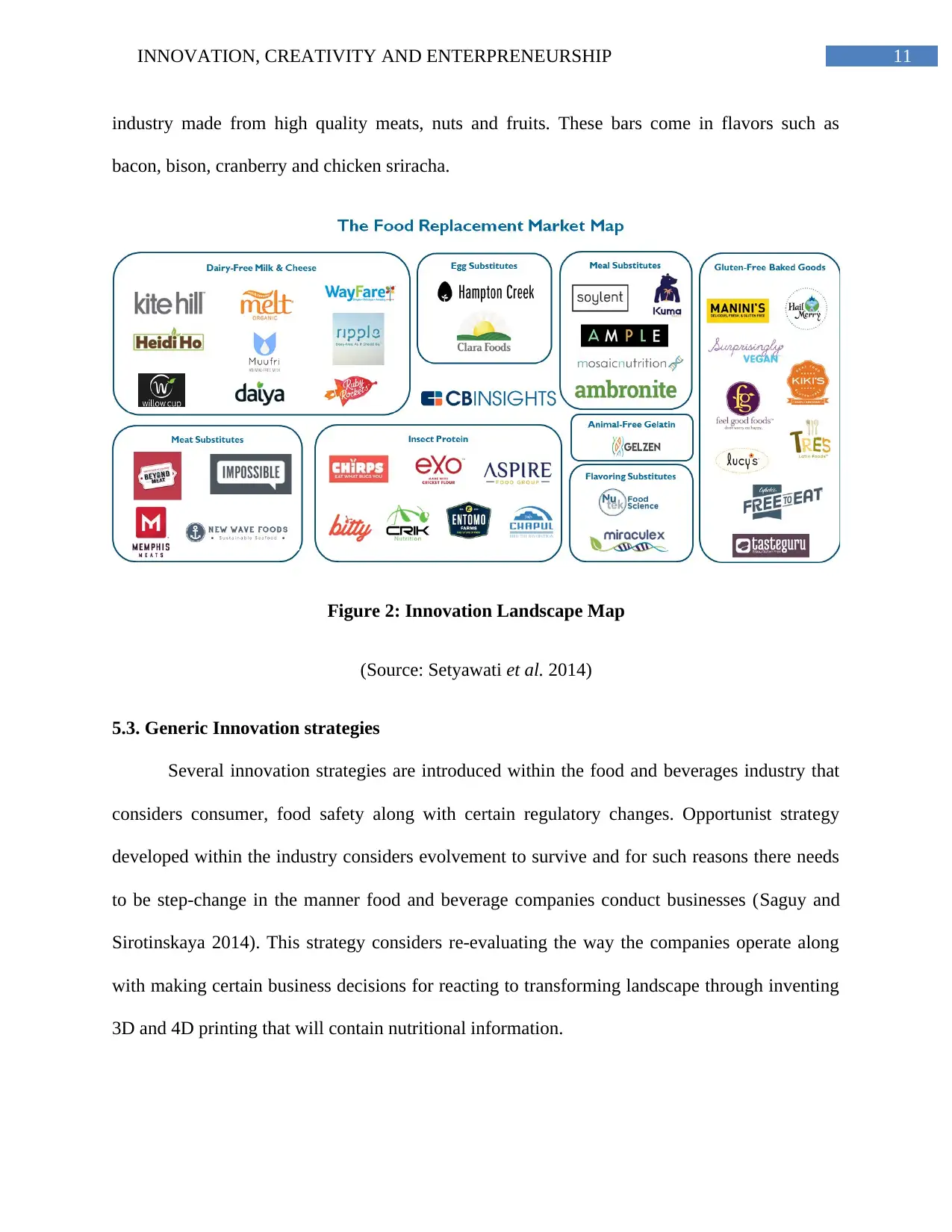
11INNOVATION, CREATIVITY AND ENTERPRENEURSHIP
industry made from high quality meats, nuts and fruits. These bars come in flavors such as
bacon, bison, cranberry and chicken sriracha.
Figure 2: Innovation Landscape Map
(Source: Setyawati et al. 2014)
5.3. Generic Innovation strategies
Several innovation strategies are introduced within the food and beverages industry that
considers consumer, food safety along with certain regulatory changes. Opportunist strategy
developed within the industry considers evolvement to survive and for such reasons there needs
to be step-change in the manner food and beverage companies conduct businesses (Saguy and
Sirotinskaya 2014). This strategy considers re-evaluating the way the companies operate along
with making certain business decisions for reacting to transforming landscape through inventing
3D and 4D printing that will contain nutritional information.
industry made from high quality meats, nuts and fruits. These bars come in flavors such as
bacon, bison, cranberry and chicken sriracha.
Figure 2: Innovation Landscape Map
(Source: Setyawati et al. 2014)
5.3. Generic Innovation strategies
Several innovation strategies are introduced within the food and beverages industry that
considers consumer, food safety along with certain regulatory changes. Opportunist strategy
developed within the industry considers evolvement to survive and for such reasons there needs
to be step-change in the manner food and beverage companies conduct businesses (Saguy and
Sirotinskaya 2014). This strategy considers re-evaluating the way the companies operate along
with making certain business decisions for reacting to transforming landscape through inventing
3D and 4D printing that will contain nutritional information.
⊘ This is a preview!⊘
Do you want full access?
Subscribe today to unlock all pages.

Trusted by 1+ million students worldwide
1 out of 21
Related Documents
Your All-in-One AI-Powered Toolkit for Academic Success.
+13062052269
info@desklib.com
Available 24*7 on WhatsApp / Email
![[object Object]](/_next/static/media/star-bottom.7253800d.svg)
Unlock your academic potential
Copyright © 2020–2025 A2Z Services. All Rights Reserved. Developed and managed by ZUCOL.





